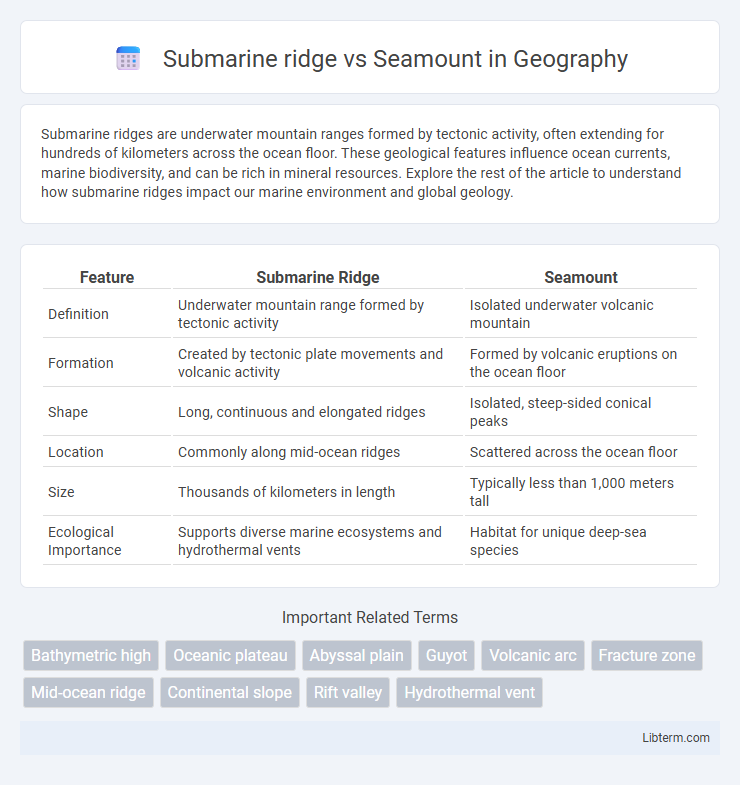Submarine ridges are underwater mountain ranges formed by tectonic activity, often extending for hundreds of kilometers across the ocean floor. These geological features influence ocean currents, marine biodiversity, and can be rich in mineral resources. Explore the rest of the article to understand how submarine ridges impact our marine environment and global geology.
Table of Comparison
| Feature | Submarine Ridge | Seamount |
|---|---|---|
| Definition | Underwater mountain range formed by tectonic activity | Isolated underwater volcanic mountain |
| Formation | Created by tectonic plate movements and volcanic activity | Formed by volcanic eruptions on the ocean floor |
| Shape | Long, continuous and elongated ridges | Isolated, steep-sided conical peaks |
| Location | Commonly along mid-ocean ridges | Scattered across the ocean floor |
| Size | Thousands of kilometers in length | Typically less than 1,000 meters tall |
| Ecological Importance | Supports diverse marine ecosystems and hydrothermal vents | Habitat for unique deep-sea species |
Introduction to Submarine Ridges and Seamounts
Submarine ridges are extensive underwater mountain ranges formed by tectonic plate movements, often spanning thousands of kilometers along ocean basins and playing a critical role in seafloor spreading and oceanic crust formation. Seamounts are isolated, submerged volcanic mountains rising from the ocean floor, typically not reaching the water's surface, and serve as biodiversity hotspots and key habitats for marine life. Both features significantly influence ocean circulation, marine ecosystems, and geological processes beneath the ocean surface.
Defining Submarine Ridges
Submarine ridges are long, elevated underwater mountain ranges formed by tectonic plate movements and volcanic activity, often extending for thousands of kilometers along the ocean floor. Unlike seamounts, which are isolated, conical underwater mountains typically rising sharply from the seafloor, submarine ridges create continuous topographic highs that influence ocean currents and marine biodiversity. These ridges play a crucial role in seafloor spreading processes and serve as habitats for diverse marine species, impacting global geological and ecological systems.
Understanding Seamounts
Seamounts are underwater mountains formed by volcanic activity, typically rising sharply from the ocean floor but not reaching the water's surface, distinguishing them from submarine ridges, which are elongated underwater mountain chains formed by tectonic processes. Understanding seamounts involves exploring their role as biodiversity hotspots and their influence on ocean currents and marine ecosystems due to their isolated, elevated structures. These features are crucial for studying marine biology, geology, and oceanography, providing habitats for unique species and affecting nutrient distribution in deep-sea environments.
Geological Formation Processes
Submarine ridges form primarily through tectonic plate movements and volcanic activity at divergent boundaries, creating elongated underwater mountain ranges such as the Mid-Atlantic Ridge. Seamounts originate from isolated volcanic eruptions on the ocean floor, resulting in singular, often cone-shaped underwater mountains that do not reach the surface. Both features contribute to oceanic crust formation but differ fundamentally in genesis, with ridges linked to seafloor spreading and seamounts associated with hotspot volcanism or intraplate volcanic activity.
Morphological Differences
Submarine ridges are elongated, elevated features on the ocean floor formed by tectonic plate movements, characterized by long, continuous underwater mountain chains. Seamounts are isolated, steep-sided volcanic peaks rising from the seafloor but not reaching the ocean surface. Morphologically, ridges exhibit linear, extensive structures often associated with mid-ocean ridges, while seamounts present as solitary, conical elevations scattered across ocean basins.
Locations and Distribution
Submarine ridges are extensive underwater mountain chains predominantly found along tectonic plate boundaries, such as the Mid-Atlantic Ridge and the East Pacific Rise, forming the longest mountain ranges on Earth. Seamounts are isolated underwater volcanic mountains scattered across ocean basins, with high concentrations located in the Pacific Ocean, particularly around hotspot regions like the Hawaiian-Emperor seamount chain. While submarine ridges define plate boundaries and exhibit linear distributions, seamounts exhibit more sporadic, clustered patterns influenced by localized volcanic activity.
Ecological Significance
Submarine ridges and seamounts serve as critical habitats for diverse marine species, enhancing biodiversity and supporting complex ecosystems. Submarine ridges act as migration pathways and nutrient upwelling zones, promoting primary productivity and sustaining fish populations. Seamounts provide isolated environments that function as biodiversity hotspots and breeding grounds for endemic species, crucial for marine conservation efforts.
Role in Oceanography
Submarine ridges, such as the Mid-Atlantic Ridge, play a crucial role in oceanography by influencing oceanic crust formation, seismic activity, and hydrothermal vent ecosystems, serving as key sites for plate tectonics studies. Seamounts, isolated underwater mountains, contribute significantly to oceanography by enhancing marine biodiversity, affecting ocean currents, and acting as hotspots for nutrient upwelling and biological productivity. Both features are essential for understanding seafloor morphology, ocean circulation patterns, and habitats that support various marine species.
Human Interaction and Exploration
Submarine ridges, often extending thousands of kilometers underwater, play vital roles in marine navigation and scientific research, serving as pathways for undersea cable installations and sites for geological studies. Seamounts, isolated underwater mountains rising from the ocean floor, attract significant interest for deep-sea biodiversity exploration and potential mineral resource extraction. Human interaction with these features includes advanced submarine mapping, remote-operated vehicle (ROV) surveys, and sustainable management efforts to balance exploration with marine ecosystem preservation.
Comparative Summary: Submarine Ridge vs Seamount
A submarine ridge is an extended underwater mountain chain formed by tectonic plate movements, often spanning hundreds of kilometers, while a seamount is an isolated, standalone underwater peak resulting from volcanic activity. Submarine ridges typically have a linear, continuous structure and influence oceanic currents and marine biodiversity over large areas, whereas seamounts are discrete features that create localized ecosystems and serve as hotspots for marine life. The geological formation, scale, and ecological impact distinguish submarine ridges from seamounts in marine geology and oceanography.
Submarine ridge Infographic

 libterm.com
libterm.com